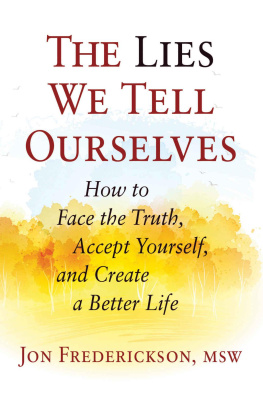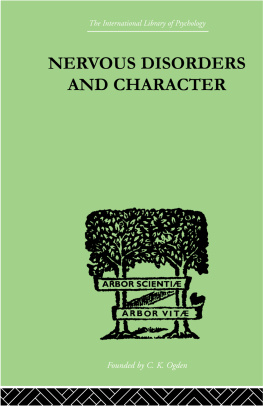Jon Frederickson - Psychodynamic Psychotherapy: Learning to Listen from Multiple Perspectives
Here you can read online Jon Frederickson - Psychodynamic Psychotherapy: Learning to Listen from Multiple Perspectives full text of the book (entire story) in english for free. Download pdf and epub, get meaning, cover and reviews about this ebook. year: 2013, publisher: Routledge, genre: Religion. Description of the work, (preface) as well as reviews are available. Best literature library LitArk.com created for fans of good reading and offers a wide selection of genres:
Romance novel
Science fiction
Adventure
Detective
Science
History
Home and family
Prose
Art
Politics
Computer
Non-fiction
Religion
Business
Children
Humor
Choose a favorite category and find really read worthwhile books. Enjoy immersion in the world of imagination, feel the emotions of the characters or learn something new for yourself, make an fascinating discovery.

- Book:Psychodynamic Psychotherapy: Learning to Listen from Multiple Perspectives
- Author:
- Publisher:Routledge
- Genre:
- Year:2013
- Rating:5 / 5
- Favourites:Add to favourites
- Your mark:
- 100
- 1
- 2
- 3
- 4
- 5
Psychodynamic Psychotherapy: Learning to Listen from Multiple Perspectives: summary, description and annotation
We offer to read an annotation, description, summary or preface (depends on what the author of the book "Psychodynamic Psychotherapy: Learning to Listen from Multiple Perspectives" wrote himself). If you haven't found the necessary information about the book — write in the comments, we will try to find it.
Jon Frederickson: author's other books
Who wrote Psychodynamic Psychotherapy: Learning to Listen from Multiple Perspectives? Find out the surname, the name of the author of the book and a list of all author's works by series.
Psychodynamic Psychotherapy: Learning to Listen from Multiple Perspectives — read online for free the complete book (whole text) full work
Below is the text of the book, divided by pages. System saving the place of the last page read, allows you to conveniently read the book "Psychodynamic Psychotherapy: Learning to Listen from Multiple Perspectives" online for free, without having to search again every time where you left off. Put a bookmark, and you can go to the page where you finished reading at any time.
Font size:
Interval:
Bookmark:
PSYCHODYNAMIC PSYCHOTHERAPY
PSYCHODYNAMIC PSYCHOTHERAPY
Learning to Listen from Multiple Perspectives
By
Jon Frederickson, M.S.W.
Chair, Advanced Psychotherapy Training Program Washington School of Psychiatry

Published in 1999 by
Routledge
Taylor & Francis Group
711 Third Avenue
New York, NY 10017
Published in Great Britain by
Routledge
Taylor & Francis Group
2 Park Square
Milton Park, Abingdon
Oxon OX14 4RN
1999 by Taylor & Francis Group, LLC
Routledge is an imprint of Taylor & Francis Group
International Standard Book Number-10: 0-87630-962-7 (Softcover)
International Standard Book Number-13: 978-0-87630-962-9 (Softcover)
Library of Congress catalog number: 98-47697
Except as permitted by U.S. Copyright Law, no part of this book may be reprinted, reproduced, transmitted, or utilized in any form by any electronic, mechanical, or other means, now known or hereafter invented, including photocopying, microfilming, and recording, or in any information storage or retrieval system, without written permission from the publishers.
Trademark Notice: Product or corporate names may be trademarks or registered trademarks, and are used only for identification and explanation without intent to infringe.
Library of Congress Cataloging-in-Publication Data
Catalog record is available from the Library of Congress
Visit the Taylor & Francis Web site at
http://www.taylorandfrancis.com
and the Routledge Web site at
http://www.routledge.com
CONTENTS
ACKNOWLEDGMENTS
Any book of this sort synthesizes what one has learned from teachers, supervisors, colleagues, students, and, most importantly, ones patients. Pascal is reputed to have said of those authors who always refer to their works as my book, my commentary, my history, etc., that they sound like solid citizens with a place of their own, always talking about my house. They would do better, this excellent man added, to say Our book, our commentary, our history, etc., considering that there is usually more of other peoples property in it than their own (Pascal 1966:355).
Yet any acknowledgment would be inadequate if I did not highlight the role of the Washington School of Psychiatry in my traininga school dedicated to keeping the questions open. During my training, I was supervised by a former behaviorist, a Sullivanian, a Fairbairnian, and someone who was trained both by Anna Freud and Kleinians! Although my supervisors worked most of the time from a given theoretical perspective, each of them felt free to draw from anything that would help the patient. I entered training looking for answers, but they questioned every answer I had, insisting instead that I learn to think. One day a supervisor asked me what would be five different ways I could respond to a patient at a given moment! And there I had been wondering what might be the one, right, correct response! They were trying to teach me flexibility so l could use any approach rather than be the hostage of one approach, trapped without an alternative. I feel especially grateful to them for their help, their patience, and their insistence on flexibility of approach. I would like to thank Sarah Pillsbury, Michael McDermott, Mike Stadter, Harold Eist, Sue Roth, Louise DeLeeuw, Elizabeth Harper, Irv Scheider, Gerry Perman, Bernardo Hirschman, Elizabeth Buchanek, Damon Silver, Rosemary Segalla, Monroe Pray, Alberto Pieczanski, and Jack Love for their contributions to this book.
In addition, I would like to single out Nicole Lediard, Nancy Griscom, Maggie Silberstein, Terry DiNuzzo, Barton Evans, and Olga Meerson for their close reading of the manuscript and extremely helpful comments. I would also like to thank the students who read previous drafts, raised useful questions, and, most generously, shared case material from early stages of their work. Since some of their early sessions were used here, their names must remain anonymous, so to them I owe a special debt of gratitude.
PREFACE
Crafty men condemn Studies, Simple men admire them, and wise men use them: for they teach not their own use, but that there is a Wisdom without them, and above them won by Observation. Francis Bacon, Of Studies, Essays (1625)
This book is designed to help you develop basic skills of psychodynamic therapy: reflecting the patients feelings, identifying conflict, hearing unconscious communication, and interpreting defenses. Without a solid understanding of basic principles, we cannot understand more complex theories and approaches. Therapists often lack this understanding because our classes emphasized the learning of theories rather than their application. Classes often appear irrelevant because in practical terms they are. What good does it do to be able to define transference if we cant hear or interpret it? Or to be able to recite a list of defenses but be unable to identify them in the session and interpret them? Knowing a theory without being able to use it is like knowing how to identify a car but being unable to drive it. No wonder much of psychodynamic theory as taught today appears to be useless!
This book provides exercises thatif applied in the right waywill show you how to translate four different theories into practice. Its theoretical content has been set forth and explained countless times before. Unfortunately, however, most books present theory in a form accessible only to a fairly advanced therapist already familiar with the theory and technique. Such a therapist will find in them a remarkably good survey of the basic material, but beginners (or experienced therapists new to psychodynamic theory) are unable to digest the material, know what it looks like in practice, or select what is useful. Moreover, the examples given in such books (when any are given) are insufficient.
There is a severe lack of specialized works, full of exercises, that would develop the therapists skills. These studies are designed to fill that lack. Actual therapy sessions are analyzed with possible interpretations to illustrate the relationship of theory to practice.
Some may object that other listening approaches were not included. This is unavoidable in a single volume. Psychodynamic theory serves as an umbrella term covering many different listening strategies. I have chosen four listening approaches because the majority of psychodynamic approaches, whether self psychology, object relations, interpersonal, or relational, require the specific listening skills studied here. Learning these skills will provide you with the background necessary to acquire a deeper understanding of other approaches.
Others may object that this book places too great an emphasis upon technique, ignoring the artistic and intuitive aspects of psychotherapy. Yet this objection would be regarded as invalid to those trained in the fine arts, whether painting, sculpture, or music. Professional musicians, for instance, practice scales and arpeggios every day. They recognize that artistry is possible only when they have technical command of their instrument. They would agree that technique without intuition is not great art; but they would also insist that intuition without technical mastery is always arbitrary, incapable of accurately interpreting the composers intentions. To give voice to the composers intent, the musician must not only be able to hear his intent but convey it through his technical mastery. Every musicians artistry begins with a mastery of techniqueit just doesnt end there. Think of this book as a set of musical etudes designed to enhance your artistry when interpreting the human dramas encountered in therapy. View it as merely a signpost, something that helps you get to your destination but is not the destination itself.
Next pageFont size:
Interval:
Bookmark:
Similar books «Psychodynamic Psychotherapy: Learning to Listen from Multiple Perspectives»
Look at similar books to Psychodynamic Psychotherapy: Learning to Listen from Multiple Perspectives. We have selected literature similar in name and meaning in the hope of providing readers with more options to find new, interesting, not yet read works.
Discussion, reviews of the book Psychodynamic Psychotherapy: Learning to Listen from Multiple Perspectives and just readers' own opinions. Leave your comments, write what you think about the work, its meaning or the main characters. Specify what exactly you liked and what you didn't like, and why you think so.








